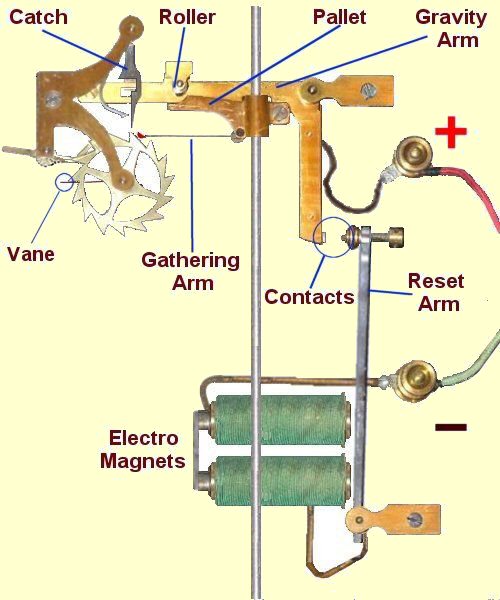Each time the pendulum (the rod part of which is shown hanging centrally above) swings back to the right the gathering arm pulls the wheel clockwise by a single tooth. As there are 15 teeth on the wheel it takes 30 seconds to go around one complete turn. (1 second swinging to the right when it pulls the wheel around, and another second used whilst it swings back again)
The wheel has a vane (circled at the 9 o' clock position) projecting out from its arbor (axis spindle) that just catches on the end of the catch when the vane moves around to that position. The catch therefore is operated once every 30 seconds. When this happens the gravity arm that was being retained by the catch, now drops downwards (its pivoted at its right end) and a tiny roller attached to this arm, comes into contact with the curved face of the impulse pallet immediately below it. This gives the pendulum a gentle push to the right.
As the pendulum and its attached pallet continue the swing to the right, the roller is able to travel further down the sloping face of the pallet giving impulse to the pendulum all the time.
Located at the bottom of the gravity arm is an electrical contact (circled on photo) which because of the fact that the arm is swinging downwards in an arc means it will eventually make contact with a similar fixed contact on the reset arm.
Once these contacts meet and complete a circuit, the electro magnets operate and this attracts the reset arm. The reset arm still has the gravity arm resting against its contact, and the resulting effect is that when the reset arm is attracted to the magnets, it flicks the gravity arm back up to where it came from. The spring loaded catch then catches, and holds, the gravity arm back in its locked position once again.
At the same time as the gravity arm is flicked back up, the electrical contact is also broken so the magnets then immediately release the reset arm. By the time this happens however the gravity arm has already been stowed safely away and held by the catch.
The whole operation is over in around a fifth of a second, and you can visually just make out the arm dropping and then you hear a satisfying clunk as it is reset.
The same electrical pulse that operates the magnets is also used to operate any slave clocks that are connected. The slave dials are in fact wired in series with the clock. This ingenious sequence of events therefore means the pendulum gets a gentle push every 30 seconds and the slave dials, which are designed to only move in 30 second steps, are moved onwards at the same time.
The exact positioning of these components and the curve to their surfaces, are what determines the degree of accuracy the clock will achieve. The impulse must cause as little disturbance as possible to the pendulum's motion. In the case of Synchronomes that were built from the kits that the company used to supply, poor workmanship in this area is the usual reason for bad timekeeping. Just because the kit built clock looks 'right', it does not mean to say it will keep good time.
Original Synchronome Literature and Instructions






